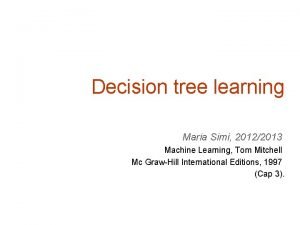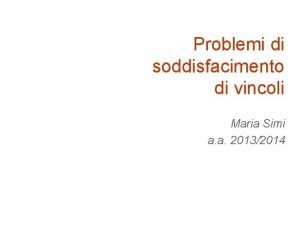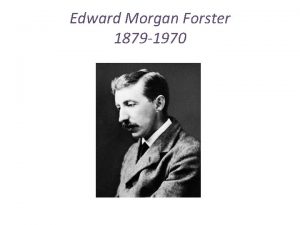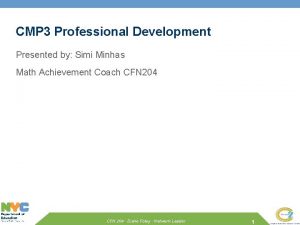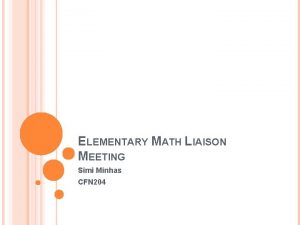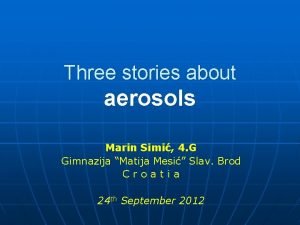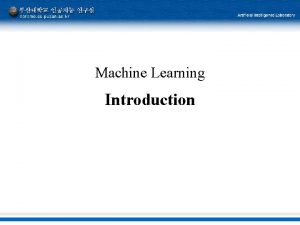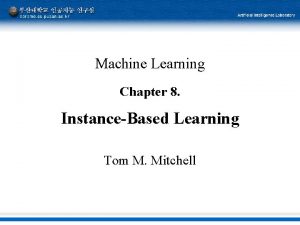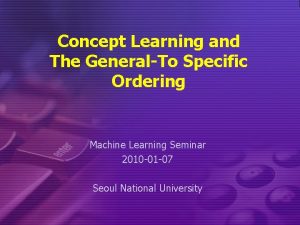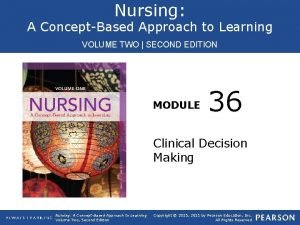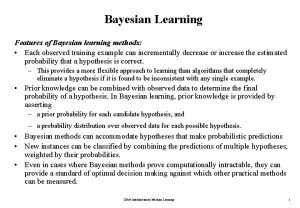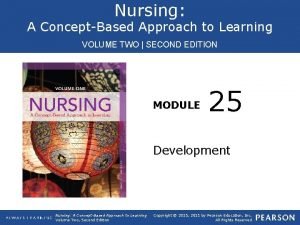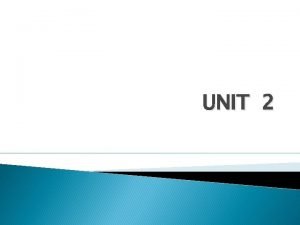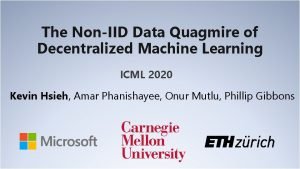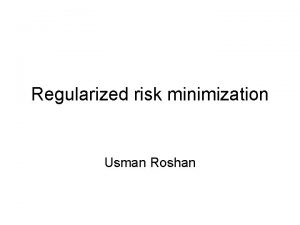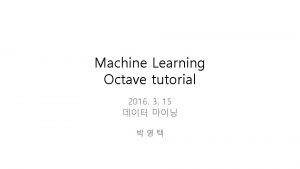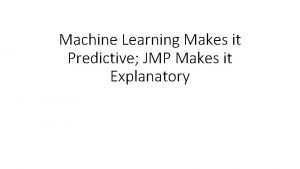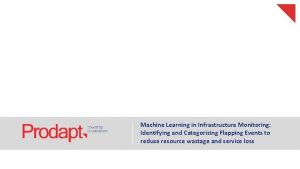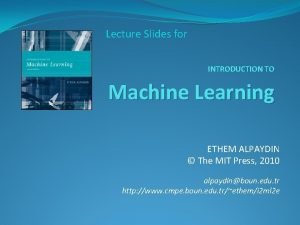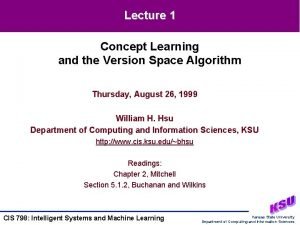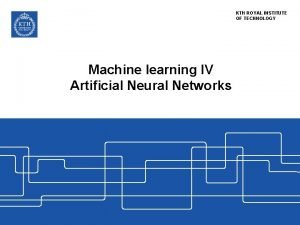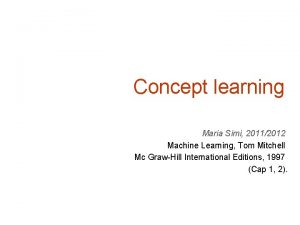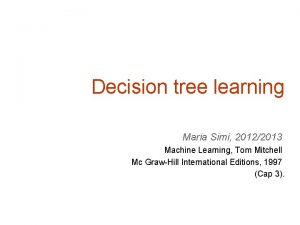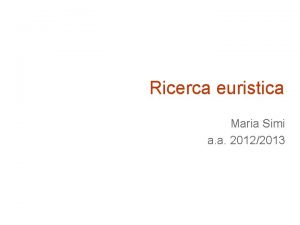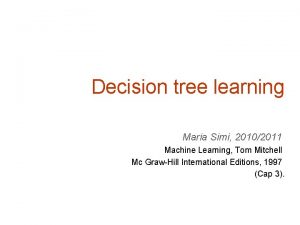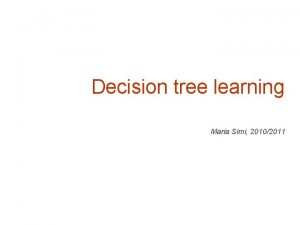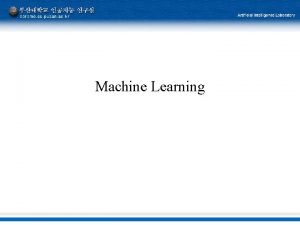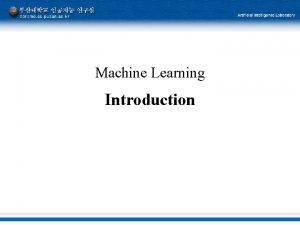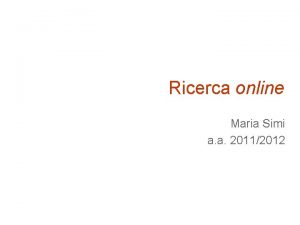Concept learning Maria Simi 20122013 Machine Learning Tom


















































- Slides: 50

Concept learning Maria Simi, 2012/2013 Machine Learning, Tom Mitchell Mc Graw-Hill International Editions, 1997 (Cap 1, 2).

Introduction to machine learning § § § When appropriate and when not appropriate Task definition Learning methodology: design, experiment, evaluation Learning issues: representing hypothesis Learning paradigms § § § Supervised learning Unsupervised learning Reinforcement learning

AIMA learning architecture

Machine learning: definition § § A computer program is said to learn from experience E with respect to some class of tasks T and performance measure P, if its performance at tasks in T, as measured by P, improves with experience E [Mitchell] Problem definition for a learning agent § § § Task T Performance measure P Experience E

Designing a learning system Choosing the training experience 1. § Examples of best moves, games outcome … Choosing the target function 2. § board-move, board-value, … Choosing a representation for the target function 3. § linear function with weights (hypothesis space) Choosing a learning algorithm for approximating the target function 4. § A method for parameter estimation

Design of a learning system Mitchell

Inductive learning § § § Inducing a general function from training examples A supervised paradigm Basic schemas that assume a logical representation of the hypothesis § § § Concept learning Decision trees learning Important issues § § § Inductive bias (definition) The problem of overfitting Bibliography: § Mitchell, cap 1, 2, 3

Definition of concept learning § Task: learning a category description (concept) from a set of positive and negative training examples. § § Concept may be a set of events, objects … Target function: a boolean function c: X {0, 1} Experience: a set of training instances D: { x, c(x) } A search problem for best hypothesis in a hypotheses space § The space is determined by the choice of representation of the hypothesis (all boolean functions

Sport example § Concept to be learned: Days in which Aldo can enjoy water sport Attributes: Sky: Sunny, Cloudy, Rainy Air. Temp: Warm, Cold Humidity: Normal, High § Wind: Strong, Weak Water: Warm, Cool Forecast: Same, Change Instances in the training set (out of the 96 possible):

Hypotheses representation § h is a set of constraints on attributes: § § a specific value: e. g. Water = Warm any value allowed: e. g. Water = ? no value allowed: e. g. Water = Ø Example hypothesis: Sky Air. Temp Humidity Wind Water Forecast Sunny, ? , Strong, ? , Same Corresponding to boolean function: Sky=Sunny ∧ Wind=Strong ∧ Forecast=Same § H, hypotheses space, all “representable” h

Hypothesis satisfaction § An instance x satisfies an hypothesis h iff all the constraints expressed by h are satisfied by the attribute values in x. § Example 1: x 1: Sunny, Warm, Normal, Strong, Warm, Same h 1: Sunny, ? , Strong, ? , Same Satisfies? Yes § Example 2: x 2: Sunny, Warm, Normal, Strong, Warm, Same h 2: Sunny, ? , Ø, ? , Same Satisfies? No

Formal task description § Given: § § § X all possible days, as described by the attributes A set of hypothesis H, a conjunction of constraints on the attributes, representing a function h: X {0, 1} [h(x) = 1 if x satisfies h; h(x) = 0 if x does not satisfy h] A target concept: c: X {0, 1} where c(x) = 1 iff Enjoy. Sport = Yes; c(x) = 0 iff Enjoy. Sport = No; § § A training set of possible instances D: { x, c(x) } Goal: find a hypothesis h in H such that h(x) = c(x) for all x in X Hopefully h will be able to predict outside D…

The inductive learning assumption § § § We can at best guarantee that the output hypothesis fits the target concept over the training data Assumption: an hypothesis that approximates well the training data will also approximate the target function over unobserved examples i. e. given a significant training set, the output hypothesis is able to make predictions

Concept learning as search § § § Concept learning is a task of searching an hypotheses space The representation chosen for hypotheses determines the search space In the example we have: § 3 x 25 = 96 possible instances (6 attributes) § 1 + 4 x 35= 973 possible hypothesis considering that all the hypothesis with some are semantically equivalent, i. e. inconsistent § Structuring the search space may help in searching more efficiently

General to specific ordering § § Consider: h 1 = Sunny, ? , Strong, ? h 2 = Sunny, ? , ? , ? Any instance classified positive by h 1 will also be classified positive by h 2 is more general than h 1 Definition: hj g hk iff ( x X ) [(hk = 1) (hj = 1)] g more general or equal; >g strictly more general § Most general hypothesis: ? , ? , ? , ? § Most specific hypothesis: Ø, Ø, Ø, Ø

General to specific ordering: induced structure

Find-S: finding the most specific hypothesis § 1. 2. Exploiting the structure we have alternatives to enumeration … Initialize h to the most specific hypothesis in H For each positive training instance: for each attribute constraint a in h: If the constraint a is satisfied by x then do nothing else replace a in h by the next more general constraint satified by x (move towards a more general hp) 3. Output hypothesis h

Find-S in action

Properties of Find-S § § § Find-S is guaranteed to output the most specific hypothesis within H that is consistent with the positive training examples The final hypothesis will also be consistent with the negative examples Problems: § § § There can be more than one “most specific hypotheses” We cannot say if the learner converged to the correct target Why choose the most specific? If the training examples are inconsistent, the algorithm can be mislead: no tolerance to rumor. Negative example are not considered

Candidate elimination algorithm: the idea § § The idea: output a description of the set of all hypotheses consistent with the training examples (correctly classify training examples). Version space: a representation of the set of hypotheses which are consistent with D § § an explicit list of hypotheses (List-Than-Eliminate) a compact representation of hypotheses which exploits the more_general_than partial ordering (Candidate-Elimination)

Version space § The version space VSH, D is the subset of the hypothesis from H consistent with the training example in D VSH, D {h H | Consistent(h, D)} § An hypothesis h is consistent with a set of training examples D iff h(x) = c(x) for each example in D Consistent(h, D) ( x, c(x) D) h(x) = c(x)) Note: "x satisfies h" (h(x)=1) different from “h consistent with x" In particular when an hypothesis h is consistent with a negative example d = x, c(x)=No , then x must not satisfy h

The List-Then-Eliminate algorithm Version space as list of hypotheses 1. Version. Space a list containing every hypothesis in H 2. For each training example, x, c(x) Remove from Version. Space any hypothesis h for which h(x) c(x) § Output the list of hypotheses in Version. Space 1. Problems 1. 2. The hypothesis space must be finite Enumeration of all the hypothesis, rather inefficient

A compact representation for Version Space Note: The output of Find-S is just Sunny, Warm, ? , Strong, ? § Version space represented by its most general members G and its most specific members S (boundaries)

General and specific boundaries § The Specific boundary, S, of version space VSH, D is the set of its minimally general (most specific) members S {s H | Consistent(s, D) ( s' H)[(s gs') Consistent(s', D)]} Note: any member of S is satisfied by all positive examples, but more specific hypotheses fail to capture some § The General boundary, G, of version space VSH, D is the set of its maximally general members G {g H | Consistent(g, D) ( g' H)[(g' g g) Consistent(g', D)]} Note: any member of G is satisfied by no negative example but more general hypothesis cover some negative example

Version Space representation theorem G and S completely define the Version Space § Theorem: Every member of the version space (h consistent with D) is in S or G or lies between these boundaries VSH, D={h H |( s S) ( g G) (g g h g s)} where x g y means x is more general or equal to y Sketch of proof: If g g h g s, since s is in S and h g s, h is satisfied by all positive examples in D; g is in G and g g h, then h is satisfied by no negative examples in D; therefore h belongs to VSH, D It can be proved by assuming a consistent h that does not satisfy the right-hand side and by showing that this §

Candidate elimination algorithm-1 S minimally general hypotheses in H, G maximally general hypotheses in H Initially any hypothesis is still possible S 0 = , , , G 0 = ? , ? , ? , ? For each training example d, do: If d is a positive example: § Remove from G any h inconsistent with d § Generalize(S, d) If d is a negative example: § Remove from S any h inconsistent with d § Specialize(G, d) Note: when d = x, No is a negative example, an hypothesis h is inconsistent with d iff h satisfies x

Candidate elimination algorithm-2 Generalize(S, d): d is positive For each hypothesis s in S not consistent with d: § Remove s from S § Add to S all minimal generalizations of s consistent with d and having a generalization in G § Remove from S any hypothesis with a more specific h in S Specialize(G, d): d is negative For each hypothesis g in G not consistent with d: i. e. g § § § satisfies d, Remove g from G but d is negative Add to G all minimal specializations of g consistent with d and having a specialization in S Remove from G any hypothesis having a more general hypothesis in G

Example: initially S 0 : , , . G 0 ? , ? , ? , ?

Example: after seing Sunny, Warm, Normal, Strong, Warm, Same + S 0 : S 1 : G 0 , G 1 , , . Sunny, Warm, Normal, Strong, Warm, Same ? , ? , ? , ?

Example: after seing Sunny, Warm, High, Strong, Warm, Same + S 1 : Sunny, Warm, Normal, Strong, Warm, Same S 2 : Sunny, Warm, ? , Strong, Warm, Same G 1 , G 2 ? , ? , ? , ?

Example: after seing Rainy, Cold, High, Strong, Warm, Change S 2, S 3: G 3 : Sunny, Warm, ? , Strong, Warm, Same Sunny, ? , ? , ? ? , Warm, ? , ? , ? , Same G 2 : ? , ? , ? , ?

Example: after seing Sunny, Warm, High, Strong, Cool Change + S 3 S 4 G 4 : G 3 : Sunny, Warm, ? , Strong, Warm, Same Sunny, Warm, ? , Strong, ? Sunny, ? , ? , ? ? , Warm, ? , ? ? , ? , ? , Same

Learned Version Space

Observations § The learned Version Space correctly describes the target concept, provided: 1. 2. § § § There are no errors in the training examples There is some hypothesis that correctly describes the target concept If S and G converge to a single hypothesis the concept is exactly learned In case of errors in the training, useful hypothesis are discarded, no recovery possible An empty version space means no hypothesis in H is consistent with training examples

Ordering on training examples § § § The learned version space does not change with different orderings of training examples Efficiency does Optimal strategy (if you are allowed to choose) § § § Generate instances that satisfy half the hypotheses in the current version space. For example: Sunny, Warm, Normal, Light, Warm, Same satisfies 3/6 hyp. Ideally the VS can be reduced by half at each experiment Correct target found in log 2|VS| experiments

Use of partially learned concepts Classified as positive by all hypothesis, since satisfies any hypothesis in S

Classifying new examples Classified as negative by all hypothesis, since does not satisfy any hypothesis in G

Classifying new examples Uncertain classification: half hypothesis are consistent, half are not consistent

Classifying new examples Sunny, Cold, Normal, Strong, Warm, Same 4 hypothesis not satisfied; 2 satisfied Probably a negative instance. Majority vote?

Questions § § § What if H does not contain the target concept? Can we improve the situation by extending the hypothesis space? Will this influence the ability to generalize? These are general questions for inductive inference, addressed in the context of Candidate -Elimination Suppose we include in H every possible hypothesis … including the ability to represent disjunctive concepts

Extending the hypothesis space Sky § § § Air. Temp Humidity Wind Water Forecast Enjoy. S 1 Sunny Warm Normal Strong Cool Change YES 2 Cloudy Warm Normal Strong Cool Change YES 3 Rainy Warm Normal Strong Cool Change NO No hypothesis consistent with the three examples with the assumption that the target is a conjunction of constraints ? , Warm, Normal, Strong, Cool, Change is too general Target concept exists in a different space H', including disjunction and in particular the hypothesis Sky=Sunny or Sky=Cloudy Removing the bias …

An unbiased learner § § Every possible subset of X is a possible target |H'| = 2|X|, or 296 (vs |H| = 973, a strong bias) This amounts to allowing conjunction, disjunction and negation Sunny, ? , ? , ? V <Cloudy, ? , ? , ? Sunny(Sky) V Cloudy(Sky) § § We are guaranteed that the target concept exists No generalization is however possible!!! Let's see why …

A bad learner § VS after presenting three positive instances x 1, x 2, x 3, and two negative instances x 4, x 5 S = {(x 1 v x 2 v x 3)} G = {¬(x 4 v x 5)} … all subsets including x 1 x 2 x 3 and not including x 4 x 5 § § We can only classify precisely examples already seen! Take a majority vote? Impossible … § § Unseen instances, e. g. x, are classified positive (and negative) by half of the hypothesis For any hypothesis h that classifies x as positive, there is a complementary hypothesis ¬h that classifies x as negative

No inductive inference without a bias § § § A learner that makes no a priori assumptions regarding the identity of the target concept, has no rational basis for classifying unseen instances The inductive bias of a learner are the assumptions that justify its inductive conclusions or the policy adopted for generalization Different learners can be charact erized by their bias

Inductive bias: definition § Given: § § § a concept learning algorithm L for a set of instances X a concept c defined over X a set of training examples for c: Dc = { x, c(x) } L(xi, Dc) outcome of classification of xi after learning Inductive inference ( ≻ ): Dc xi ≻ L(xi, Dc) The inductive bias is defined as a minimal set of assumptions B, such that (|− for deduction) (xi X) [ (B Dc xi) |− L(xi, Dc) ]

Inductive bias of Candidate. Elimination § Assume L is defined as follows: § § compute VSH, D classify new instance by complete agreement of all the hypotheses in VSH, D Then the inductive bias of Candidate-Elimination is simply B (c H) In fact by assuming c H: § § c VSH, D , in fact VSH, D includes all hypotheses in H consistent with D L(xi, Dc) outputs a classification "by complete agreement", hence any hypothesis, including c, outputs L(xi, Dc)

Inductive system

Equivalent deductive system

Each learner has an inductive bias § Three learner with three different inductive bias: Rote learner: no inductive bias, just stores examples and is able to classify only previously observed examples 2. Candidate. Elimination: the concept c is in H and is a conjunction of constraints 3. Find-S: the concept c is in H, is a conjunction of constraints plus "all instances are negative unless seen as positive examples” (stronger bias) § The stronger the bias, greater the ability to generalize and classify new instances (greater inductive leaps). 1.

Bibliography § Machine Learning, Tom Mitchell, Mc Graw-Hill International Editions, 1997 (Cap 2).
 Decision tree machine learning andrew ng
Decision tree machine learning andrew ng Sistemi a regole di produzione
Sistemi a regole di produzione Maria simi
Maria simi Maria simi
Maria simi Maria simi
Maria simi Concept learning task in machine learning
Concept learning task in machine learning Pensione simi
Pensione simi Simi minhas
Simi minhas Simi minhas
Simi minhas Simi minhas
Simi minhas Tom m. mitchell machine learning
Tom m. mitchell machine learning Machine learning tom
Machine learning tom Tom tom go 910
Tom tom go 910 The devil and tom walker symbols
The devil and tom walker symbols Maria felicia de jesús sacramentado maría teresa arminda
Maria felicia de jesús sacramentado maría teresa arminda Analytical learning in machine learning
Analytical learning in machine learning Pac learning model in machine learning
Pac learning model in machine learning Machine learning t mitchell
Machine learning t mitchell Inductive and analytical learning
Inductive and analytical learning Inductive learning
Inductive learning Instance based learning in machine learning
Instance based learning in machine learning Inductive learning machine learning
Inductive learning machine learning First order rule learning in machine learning
First order rule learning in machine learning Eager learning algorithm example
Eager learning algorithm example Cmu machine learning
Cmu machine learning Tom cruise dyslexic
Tom cruise dyslexic Ideal self vs real self
Ideal self vs real self Pengertian pemasaran
Pengertian pemasaran Finite state machine vending machine example
Finite state machine vending machine example Mealy or moore machine
Mealy or moore machine Moore machine to mealy machine
Moore machine to mealy machine Chapter 10 energy work and simple machines answer key
Chapter 10 energy work and simple machines answer key Cuadro comparativo e-learning m-learning b-learning
Cuadro comparativo e-learning m-learning b-learning Find s algorithm machine learning
Find s algorithm machine learning Nursing a concept based approach to learning volume 2
Nursing a concept based approach to learning volume 2 Brute force bayes concept learning
Brute force bayes concept learning Nursing a concept based approach to learning
Nursing a concept based approach to learning Nursing a concept based approach to learning
Nursing a concept based approach to learning Concept of learning ppt
Concept of learning ppt Bsp classification
Bsp classification Regularized risk minimization
Regularized risk minimization Sql server predictive analytics
Sql server predictive analytics Azure machine learning studio
Azure machine learning studio Octave tutorial machine learning
Octave tutorial machine learning Principal component analysis jmp
Principal component analysis jmp Machine learning in infrastructure monitoring
Machine learning in infrastructure monitoring Machine learning actuary
Machine learning actuary Zillow data mining
Zillow data mining Ethem alpaydin
Ethem alpaydin Hypothesis space in machine learning
Hypothesis space in machine learning Kth machine learning
Kth machine learning
